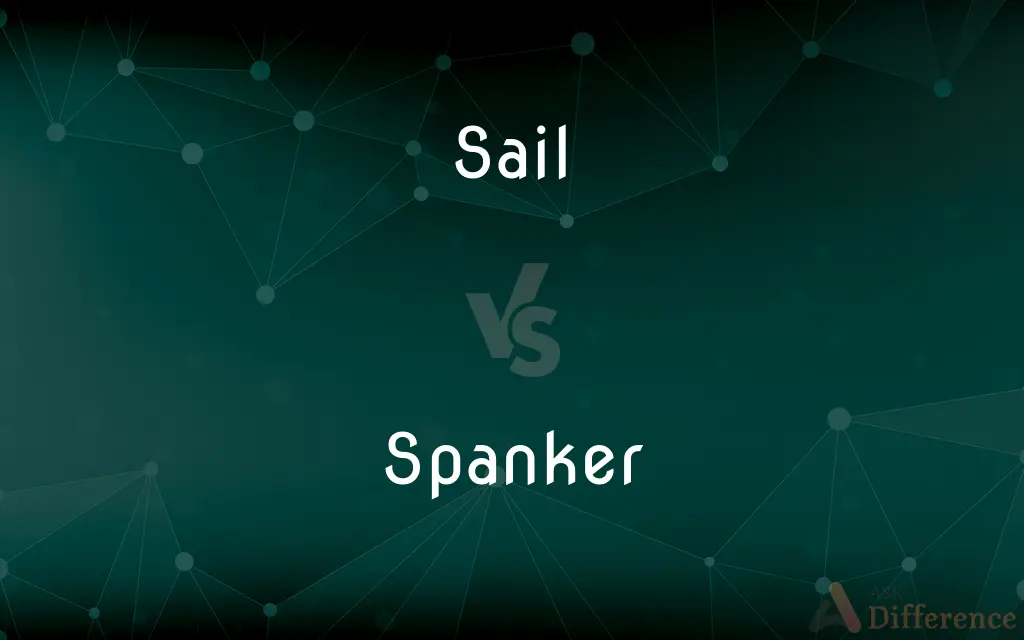Sail vs. Spanker — What's the Difference?
By Tayyaba Rehman & Fiza Rafique — Updated on April 5, 2024
Sail is a broad term for any type of fabric used to catch wind for propulsion on water, while a spanker is a specific type of sail on the aft-most mast of a square-rigged ship.

Difference Between Sail and Spanker
Table of Contents
ADVERTISEMENT
Key Differences
Sails are essential components of various watercraft, designed to harness wind power to propel vessels across water. They come in different shapes, sizes, and configurations, depending on the type of vessel and its sailing requirements. On the other hand, a spanker is a specific type of sail found on square-rigged ships, typically positioned on the aft-most mast. It is usually a fore-and-aft sail, which means it is set along the line of the keel rather than perpendicular to it, as with square sails.
Sails can be made from a variety of materials, including traditional canvas or modern synthetic fabrics, and are used on a wide range of sailing vessels from small dinghies to large tall ships. The spanker helps in maneuvering and balancing the ship, especially when tacking or sailing close to the wind.
While sails are a generic term encompassing all wind-catching surfaces on a vessel, the spanker's role is more specialized, contributing to the nuanced handling of a square-rigged ship. Sails can be the primary or sole method of propulsion, whereas the spanker is part of a larger array of sails on a vessel, each with its specific function for optimal sailing efficiency.
Sails vary widely in their design and application, with some designed for speed, others for maneuverability, and yet others for stability. Sail types include mainsails, jibs, spinnakers, and genoas, among others. Each type of sail is adapted to a particular sailing condition and purpose, demonstrating the versatility and adaptability of sails as a means of marine propulsion. The spanker, while being just one type of sail, plays a crucial role in the aerodynamics and handling of square-rigged ships. It is often used in combination with other sails to adjust the ship's balance and direction. The precise setting of the spanker can significantly affect the ship's performance, especially in challenging weather conditions or when precise maneuvers are required.
Comparison Chart
Definition
A piece of material used to catch wind for propulsion on water.
A specific type of fore-and-aft sail located on the aft-most mast of a square-rigged ship.
ADVERTISEMENT
Function
Propulsion and maneuverability for various types of watercraft.
Assists in maneuvering and balancing square-rigged ships, especially during tacking.
Types
Includes mainsails, jibs, spinnakers, genoas, etc.
One specific type, varying only in size relative to the ship.
Placement
Can be found on any mast or part of the vessel, depending on the design.
Always located on the aft-most mast of a square-rigged ship.
Material
Made from canvas, polyester, or other modern synthetic materials.
Typically made from the same materials as other sails on the ship.
Compare with Definitions
Sail
A piece of fabric attached to a boat or ship used to catch the wind and propel the vessel forward.
The bright red sail stood out against the blue sky.
Spanker
A term referring to the aft sail that helps in steering and balancing large ships.
The captain ordered the spanker to be trimmed as they approached the harbor.
Sail
The act of sailing; moving across water by using wind power.
They plan to sail around the world in their yacht.
Spanker
A specific sail located on the aft-most mast of square-rigged ships, used for better control and maneuverability.
The crew adjusted the spanker to catch the wind more effectively.
Sail
A journey or adventure on a sailing vessel.
Their sail to the Caribbean was an unforgettable experience.
Spanker
Essential for precise maneuvers, especially in narrow or challenging waters.
With a quick adjustment to the spanker, they avoided the obstacle.
Sail
An event involving boats racing or cruising together.
The annual regatta is the most exciting sail of the year.
Spanker
A sail that plays a crucial role in the overall sailing efficiency of square-rigged vessels.
The new spanker improved their speed by a significant margin.
Sail
To travel by wind power on water.
The ancient mariners sailed the seas without modern navigation tools.
Spanker
Part of the ship's rigging, contributing to its aerodynamic performance.
The spanker's condition can greatly affect a ship's handling in strong winds.
Sail
A sail is a tensile structure—made from fabric or other membrane materials—that uses wind power to propel sailing craft, including sailing ships, sailboats, windsurfers, ice boats, and even sail-powered land vehicles. Sails may be made from a combination of woven materials—including canvas or polyester cloth, laminated membranes or bonded filaments—usually in a three- or four-sided shape.
Spanker
A usually gaff-headed sail set from the aftermost lower mast of a sailing ship.
Sail
A piece of material extended on a mast to catch the wind and propel a boat or ship or other vessel
All the sails were unfurled
The boat can no longer carry that area of sail
Spanker
Someone who spanks.
Sail
A wind-catching apparatus attached to the arm of a windmill.
Spanker
An instrument used to give someone a spanking or spank, such as a paddle.
Sail
A voyage or excursion in a ship, especially a sailing ship or boat
They went for a sail
Spanker
(nautical) A fore-and-aft gaff-rigged sail on the aft-most mast of a square-rigged vessel.
Sail
The conning tower of a submarine.
Spanker
A musician who plays his instrument well.
Sail
A canvas sheet or tarpaulin
The sail covering the load of crates broke loose from the truck
Spanker
A small coin.
Sail
Travel in a boat with sails, especially as a sport or recreation
Ian took us out sailing on the lake
Spanker
(dated) One who takes long, quick strides in walking.
Sail
Move smoothly and rapidly or in a stately or confident manner
The ball sailed inside the right-hand post
Spanker
(dated) A swift horse.
Sail
A piece of fabric sewn together and fitted to the spars and rigging of a vessel so as to convert the force of the wind into forward motion of the vessel.
Spanker
Something very large, or larger than usual; a whopper.
Sail
The sails of a ship or boat.
Spanker
Something splendid; a fine example of its kind.
Sail
A narrow fairwater supporting the bridge of a submarine.
Spanker
One who spanks, or anything used as an instrument for spanking.
Sail
Pl. sail or sails Nautical A sailing vessel.
Spanker
The after sail of a ship or bark, being a fore-and-aft sail attached to a boom and gaff; - sometimes called driver. See Illust. under Sail.
Sail
(Nautical) A trip or voyage in a sailing craft.
Spanker
One who takes long, quick strides in walking; also, a fast horse.
Sail
Something, such as the blade of a windmill, that resembles a sail in form or function.
Spanker
Something very large, or larger than common; a whopper, as a stout or tall person.
Sail
To move across the surface of water, especially by means of a sailing vessel.
Spanker
A small coin.
Sail
To travel by water in a vessel.
Spanker
A hitter who slaps (usually another person) with an open hand;
Someone slapped me on the back and I turned to see who the slapper was
My father was the designated spanker in our family
Sail
To start out on such a voyage or journey
Tomorrow we sail for the islands.
Spanker
A fore-and-aft sail set on the aftermost lower mast (usually the mizzenmast) of a vessel
Sail
To operate a sailing craft, especially for sport.
Sail
To move along or progress smoothly or effortlessly
Sailed into the room five minutes late.
Sailed through the exam.
Sailed through the red light.
Sail
To move along through the air
The ball sailed into the stands.
Sail
To navigate or manage (a vessel).
Sail
To voyage upon or across
Sail the Pacific.
Sail
(nautical) A piece of fabric attached to a boat and arranged such that it causes the wind to drive the boat along. The sail may be attached to the boat via a combination of mast, spars and ropes.
Sail
The concept of a sail or sails, as if a substance.
Take in sail: a storm is coming.
Sail
(uncountable) The power harnessed by a sail or sails, or the use of this power for travel or transport.
Sail
A trip in a boat, especially a sailboat.
Let's go for a sail.
Sail
A sailing vessel; a vessel of any kind; a craft.
Twenty sail were in sight.
Sail
(nautical) The conning tower of a submarine.
Sail
The blade of a windmill.
Sail
A tower-like structure found on the dorsal (topside) surface of submarines.
Sail
The floating organ of siphonophores, such as the Portuguese man-of-war.
Sail
(fishing) A sailfish.
We caught three sails today.
Sail
(paleontology) an outward projection of the spine, occurring in certain dinosaurs and synapsids
Sail
Anything resembling a sail, such as a wing.
Sail
To be impelled or driven forward by the action of wind upon sails, as a ship on water; to be impelled on a body of water by steam or other power.
Sail
To move through or on the water; to swim, as a fish or a waterfowl.
Sail
To ride in a boat, especially a sailboat.
Sail
(intransitive) To set sail; to begin a voyage.
We sail for Australia tomorrow.
Sail
To move briskly and gracefully through the air.
Sail
(intransitive) To move briskly but sedately.
The duchess sailed haughtily out of the room.
Sail
To deal out (cards) from a distance by impelling them across a surface.
Sail
An extent of canvas or other fabric by means of which the wind is made serviceable as a power for propelling vessels through the water.
Behoves him now both sail and oar.
Sail
Anything resembling a sail, or regarded as a sail.
Sail
A wing; a van.
Like an eagle soaringTo weather his broad sails.
Sail
The extended surface of the arm of a windmill.
Sail
A sailing vessel; a vessel of any kind; a craft.
Sail
A passage by a sailing vessel; a journey or excursion upon the water.
Sail
To be impelled or driven forward by the action of wind upon sails, as a ship on water; to be impelled on a body of water by the action of steam or other power.
Sail
To move through or on the water; to swim, as a fish or a water fowl.
Sail
To be conveyed in a vessel on water; to pass by water; as, they sailed from London to Canton.
Sail
To set sail; to begin a voyage.
Sail
To move smoothly through the air; to glide through the air without apparent exertion, as a bird.
As is a winged messenger of heaven, . . .When he bestrides the lazy pacing clouds,And sails upon the bosom of the air.
Sail
To pass or move upon, as in a ship, by means of sails; hence, to move or journey upon (the water) by means of steam or other force.
A thousand ships were manned to sail the sea.
Sail
To fly through; to glide or move smoothly through.
Sublime she sailsThe aërial space, and mounts the wingèd gales.
Sail
To direct or manage the motion of, as a vessel; as, to sail one's own ship.
Sail
A large piece of fabric (as canvas) by means of which wind is used to propel a sailing vessel
Sail
An ocean trip taken for pleasure
Sail
Traverse or travel by ship on (a body of water);
We sailed the Atlantic
He sailed the Pacific all alone
Sail
Move with sweeping, effortless, gliding motions;
The diva swept into the room
Shreds of paper sailed through the air
The searchlights swept across the sky
Sail
Travel in a boat propelled by wind;
I love sailing, especially on the open sea
Sail
Travel by boat on a boat propelled by wind or by other means;
The QE2 will sail to Southampton tomorrow
Common Curiosities
How does a spanker differ from other sails?
A spanker is a specific type of sail located on the aft-most mast of square-rigged ships, mainly used for maneuvering and balancing.
Can a ship sail without a spanker?
While a ship can sail without a spanker, its absence may affect maneuverability and handling, especially in square-rigged ships.
Are sails made from only one type of material?
No, sails can be made from various materials, including traditional canvas and modern synthetic fabrics.
What is the main purpose of a sail?
The main purpose of a sail is to catch wind to propel a watercraft across water.
Can all boats use a spanker sail?
No, only square-rigged ships typically use a spanker sail due to its specific placement and function.
Why is the spanker important for square-rigged ships?
The spanker plays a crucial role in the maneuvering and balancing of square-rigged ships, especially when tacking or sailing close to the wind.
How are sails maintained?
Sails are maintained through regular inspections, cleaning, and repairs as needed to ensure optimal performance and longevity.
What advancements have been made in sail technology?
Advancements in sail technology include the development of stronger, lighter materials and designs that maximize efficiency and performance.
Do modern ships still use sails?
Yes, modern ships, including recreational sailboats and some commercial vessels, still use sails for propulsion, often alongside other power sources.
How do sailors choose the right sail for conditions?
Sailors choose sails based on wind conditions, the course relative to the wind, and the specific performance characteristics of their vessel.
Share Your Discovery

Previous Comparison
Brushed vs. Suede
Next Comparison
Puritanical vs. PrudishAuthor Spotlight
Written by
Tayyaba RehmanTayyaba Rehman is a distinguished writer, currently serving as a primary contributor to askdifference.com. As a researcher in semantics and etymology, Tayyaba's passion for the complexity of languages and their distinctions has found a perfect home on the platform. Tayyaba delves into the intricacies of language, distinguishing between commonly confused words and phrases, thereby providing clarity for readers worldwide.
Co-written by
Fiza RafiqueFiza Rafique is a skilled content writer at AskDifference.com, where she meticulously refines and enhances written pieces. Drawing from her vast editorial expertise, Fiza ensures clarity, accuracy, and precision in every article. Passionate about language, she continually seeks to elevate the quality of content for readers worldwide.














































